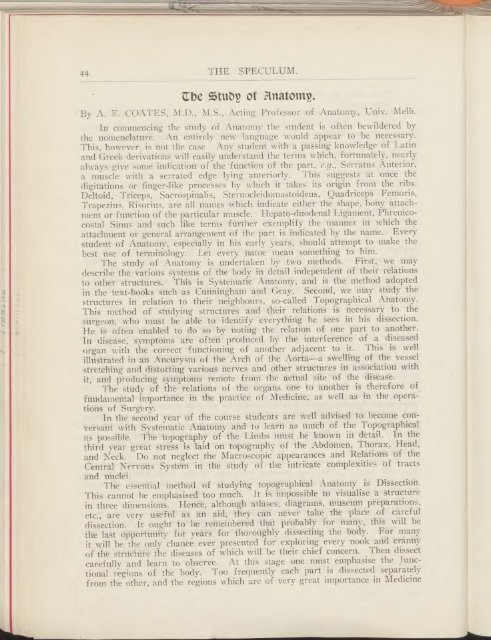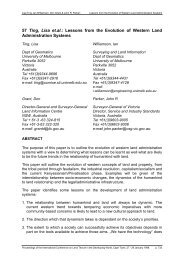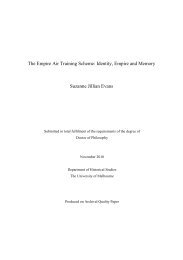Speculum : The Journal of the Melbourne Medical Students' Society ...
Speculum : The Journal of the Melbourne Medical Students' Society ...
Speculum : The Journal of the Melbourne Medical Students' Society ...
Create successful ePaper yourself
Turn your PDF publications into a flip-book with our unique Google optimized e-Paper software.
44 THE SPECULUM.Ebe $tuby <strong>of</strong> Anatomy.By A. E. COATES, M.S., Acting Pr<strong>of</strong>essor <strong>of</strong> Anatomy, Univ. Melb.In commencing <strong>the</strong> study <strong>of</strong> Anatomy <strong>the</strong> student is <strong>of</strong>ten bewildered by<strong>the</strong> nomenclature. An entirely new language would appear to he necessary.This, however,. is not <strong>the</strong> case. Any student with a passina knowledge <strong>of</strong> Latinand Greek derivations will easily understand <strong>the</strong> terms which, 6 fortunately, nearlyalways give some indication <strong>of</strong> <strong>the</strong> function <strong>of</strong> <strong>the</strong> part, e.g., Serratus Anterior,a muscle with a serrated edge lying anteriorly. This suggests at once <strong>the</strong>digitations or finger-like processes by which it takes its origin from <strong>the</strong> ribs.Deltoid, Triceps, Sacrospinalis, Sternocleidomastoideus, Quadriceps Femoris,Trapezius, Risorius, are all names which indicate ei<strong>the</strong>r <strong>the</strong> shape, bony attachmentor function <strong>of</strong> <strong>the</strong> particular muscle. Hepato-duodenal Ligament, PhrenicocostalSinus and such like terms fur<strong>the</strong>r exemplify <strong>the</strong> manner in which <strong>the</strong>attachment or general arrangement <strong>of</strong> <strong>the</strong> part is indicated by <strong>the</strong> name. Everystudent <strong>of</strong> Anatomy, especially in his early years, should attempt to make <strong>the</strong>best use <strong>of</strong> terminology. Let every name mean something to him.<strong>The</strong> study <strong>of</strong> Anatomy is undertaken by two methods. First, we maydescribe <strong>the</strong> various systems <strong>of</strong> <strong>the</strong> body in detail independent <strong>of</strong> <strong>the</strong>ir relationsto o<strong>the</strong>r structures. This is Systematic Anatomy, and is <strong>the</strong> method adoptedin <strong>the</strong> text-books such as Cunningham and Gray. Second, We may study <strong>the</strong>structures in relation to <strong>the</strong>ir neighbours, so-called Topographical Anatomy.This method <strong>of</strong> studying structures and <strong>the</strong>ir relations is necessary to <strong>the</strong>surgeon, who must be able to identify everything he sees in his dissection.He is <strong>of</strong>ten enabled to do so by noting <strong>the</strong> relation <strong>of</strong> one part to ano<strong>the</strong>r.In disease, symptoms are <strong>of</strong>ten produced by <strong>the</strong> interference <strong>of</strong> a diseasedorgan with <strong>the</strong> correct functioning <strong>of</strong> ano<strong>the</strong>r adjacent to it. This is wellillustrated in an Aneurysm <strong>of</strong> <strong>the</strong> Arch <strong>of</strong> <strong>the</strong> Aorta—a swelling <strong>of</strong> <strong>the</strong> vesselstretching and distorting various nerves and o<strong>the</strong>r structures in association withit, and producing syniptoins remote from <strong>the</strong> actual site <strong>of</strong> <strong>the</strong> disease.<strong>The</strong> study <strong>of</strong> <strong>the</strong> relations <strong>of</strong> <strong>the</strong> organs one to ano<strong>the</strong>r is <strong>the</strong>refore <strong>of</strong>fundamental importance in <strong>the</strong> practice <strong>of</strong> Medicirie, as well as iii <strong>the</strong> operations<strong>of</strong> Surgery.In <strong>the</strong> second year <strong>of</strong> <strong>the</strong> course students are well advised to become conversantwith Systematic Anatomy and to learn as much <strong>of</strong> <strong>the</strong> Topographicalas possible. <strong>The</strong> topography <strong>of</strong> <strong>the</strong> Limbs must be known in detail. In <strong>the</strong>third year great stress is laid on topography <strong>of</strong> <strong>the</strong> Abdomen, Thorax, Head,and Neck. Do not neglect <strong>the</strong> Macroscopic appearances and Relations <strong>of</strong> <strong>the</strong>Central Nervous Systeni in <strong>the</strong> study <strong>of</strong> <strong>the</strong> intricate complexities <strong>of</strong> tractsand nuclei.<strong>The</strong> essential Method <strong>of</strong> studying topographical Anatomy is Dissection.This cannot he emphasised too much. It is impossible to visualise a structurein three dimensions. HenCe, although atlases, diagrams, museum preparations,etc., are very useful as an aid, <strong>the</strong>y can never take <strong>the</strong> place <strong>of</strong> carefuldissection. It ought to be remembered that probably for rhany, this will be<strong>the</strong> last opportunity for years for thoroughly dissecting <strong>the</strong> hotly. For manyit will be <strong>the</strong> only chance ever presented for exploring every nook arid cranny<strong>of</strong> <strong>the</strong> structure <strong>the</strong> diseases <strong>of</strong> which will be <strong>the</strong>ir chief concern. <strong>The</strong>n dissectcarefully and learn to observe. At this stage one must emphasise <strong>the</strong> Junctionalregions <strong>of</strong> <strong>the</strong> body. Too frequently each part is dissected separatelyfrom <strong>the</strong> o<strong>the</strong>r, and <strong>the</strong> regions which are <strong>of</strong> very great importance in Medicine
















